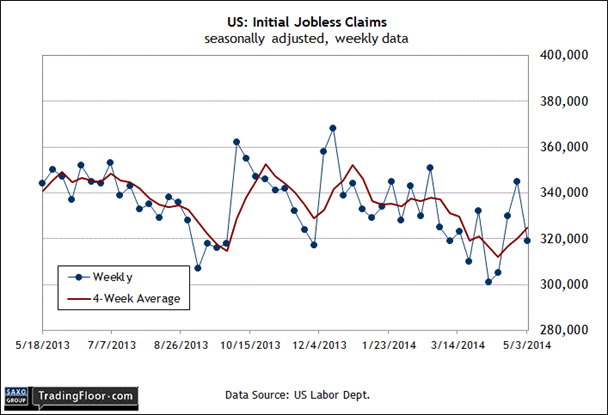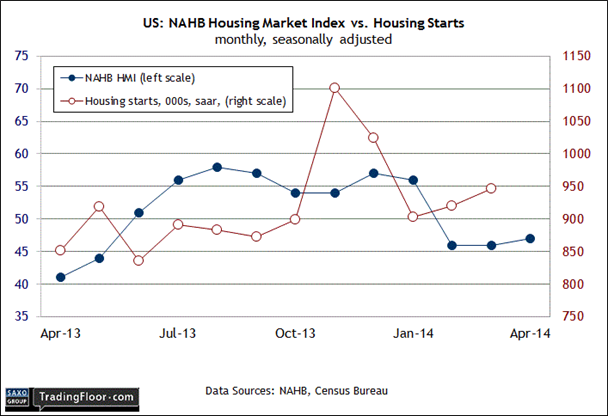• Eurozone GDP key to the ECB's next move• Mild decline expected in US initial jobless claims• US housing market slowdown to continue dragging on
Thursday is a busy day for economic releases, with several reports scheduled for Europe. The numbers will be analysed carefully in terms of how they influence the outlook for additional monetary stimulus from the European Central Bank. We’ll also see valuable macro numbers for the US, including the weekly jobless claims report and an early look at the housing market in May based on the NAHB Housing Market Index.
EU GDP (09:00 GMT): Yesterday’s disappointing news on industrial production in March strengthens the odds that the European Central Bank (ECB) will cut interest rates at its policy meeting in early June. Depending on how the economic numbers look in the days ahead, the bank may also roll out a new round of monetary stimulus next month in the form of a large-scale asset purchase programme, aka quantitative easing (QE). The latest figures certainly don’t paint an encouraging profile. Analysts were looking for a mild slowdown in the year-over-year growth of industrial activity, but the actual data showed a slight decline. On a monthly basis, output fell too, dropping 0.3 percent in March vs. the previous month.
Today’s flash GDP report for the first quarter will add more context for deciding if quantitative easing is likely. Most analysts see Eurozone GDP rising in the first three months of this year, but the decline in industrial activity raises new questions about the persistence of Europe’s feeble recovery. Indeed, all four leading economies posted lower industrial activity in March, reminding us that the latest slump on this front is widespread. The drop in durable consumer goods on a year-over-year basis looks particularly troubling. For the first time since December, annual production activity in this cyclically sensitive corner is contracting.
"Negative deposit rates are a possible part of a combination of measures," ECB executive board member Peter Praet recently advised. But the prospects for QE are still low, he added. "I think it will only come to that if the euro zone economy and inflation develop significantly worse than we expect." No wonder, then, that today’s GDP report, along with an update on Eurozone inflation (09:00 GMT), will draw broad attention today as the crowd reconsiders what the ECB will do next.

US Initial Jobless Claims (12:30 GMT): This leading indicator retreated sharply in the previous update, suggesting that the labour market will continue to expand at a healthy pace. The weekly data is volatile, but the April payrolls report posted its strongest monthly advance since January 2012. The combination of two upbeat data sets suggests that the outlook for jobs may be headed for a stronger run of growth. Some analysts note, however, that the late Easter holiday this year may have distorted the claims data in recent weeks. Maybe, but any seasonal volatility will probably fade with today’s numbers and so we'll have solid read on what's happening with regards to layoffs.
The crowd’s looking for a slight decline: new claims are expected to dip slightly to 317,000 vs. 319,000 in last week’s update. As long as new filings for unemployment benefits stay more or less unchanged at current levels, we’ll have an encouraging report. As recently as early April, claims fell to a seven-year low of 301,000. Sticking near that number will be a reminder that, despite some bumps lately, the economy is still creating jobs at a respectable pace.
For deeper perspective, keep an eye on the year-over-year change, which is a more reliable measure of the trend with layoffs. Last week’s report showed that claims were again slipping relative to the year-earlier level. If new filings continue to slide vs. a year ago, we’ll have another clue for thinking that the encouraging numbers of late are more than a seasonal glitch.

US NAHB Housing Market Index (14:00 GMT):There’s a lively debate at the moment about whether the recent weakness in housing is a temporary pause or the start of bigger trouble. The recent decline in sales certainly looks troubling…. if it continues. Deciding if there’s more pain to come starts with today’s update on the mood in the home building industry.
The Housing Market Index offered a relatively early hint at the sector’s weakness when the benchmark slumped in February, falling below the neutral 50 mark for the first time since last Spring. The below-50 readings rolled on through the April report and economists expect more of the same in today’s estimate for May. Although the consensus forecast calls for a modest rise to 49 in May, up from 47 in the previous month, that’s still below the neutral 50 mark. Even so, 49 isn’t horrible, although it suggests that housing is still suffering from a soft patch.
Predicting a darker shade of trouble at this stage is still premature. Although the hard data on sales show a retreat in demand, new residential construction has been inching higher lately, albeit at an unimpressive rate. But if today’s survey data from the National Association of Home Builders (NAHB) shows a bit of improvement, we’ll at least have some new evidence for thinking that housing’s recent slowdown is only maturing rather than ending.

